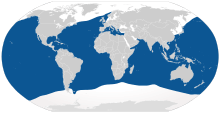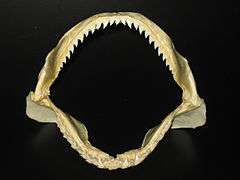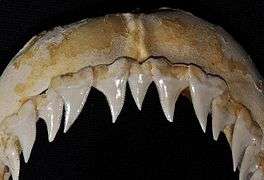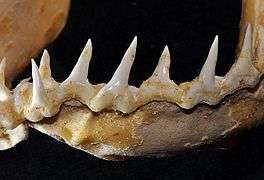Blue shark
| Blue shark Temporal range: Pliocene–Recent[1] | |
|---|---|
 | |
| Scientific classification | |
| Kingdom: | Animalia |
| Phylum: | Chordata |
| Class: | Chondrichthyes |
| Subclass: | Elasmobranchii |
| Superorder: | Selachimorpha |
| Order: | Carcharhiniformes |
| Family: | Carcharhinidae |
| Genus: | Prionace Cantor, 1849 |
| Species: | P. glauca |
| Binomial name | |
| Prionace glauca (Linnaeus, 1758) | |
 | |
| Range of the blue shark | |
The blue shark (Prionace glauca) is a species of requiem shark, in the family Carcharhinidae, that inhabits deep waters in the world's temperate and tropical oceans. Preferring cooler waters,[3] blue sharks migrate long distances, such as from New England to South America. The species is listed as Near Threatened by the IUCN.
Although generally lethargic, they can move very quickly. Blue sharks are viviparous and are noted for large litters of 25 to over 100 pups. They feed primarily on small fish and squid, although they can take larger prey. Maximum lifespan is still unknown, but it is believed that they can live up to 20 years.[4]
Anatomy and appearance
Blue sharks are light-bodied with long pectoral fins. Like many other sharks, blue sharks are countershaded: the top of the body is deep blue, lighter on the sides, and the underside is white. The male blue shark commonly grows to 1.82 to 2.82 m (6.0 to 9.3 ft) at maturity, whereas the larger females commonly grow to 2.2 to 3.3 m (7.2 to 10.8 ft) at maturity.[5] Large specimens can grow to 3.8 m (12 ft) long. Occasionally, an outsized blue shark is reported, with one widely printed claim of a length of 6.1 m (20 ft), but no shark even approaching this size has been scientifically documented.[5] The blue shark is fairly elongated and slender in build and typically weighs from 27 to 55 kg (60 to 121 lb) in males and from 93 to 182 kg (205 to 401 lb) in large females.[6][7][8] Occasionally, a female in excess of 3 m (9.8 ft) will weigh over 204 kg (450 lb). The heaviest reported weight for the species was 391 kg (862 lb).[9] The blue shark is also ectothermic and it has a unique sense of smell.
-

Eye
-

Jaws
-

Upper teeth
-

Lower teeth
Reproduction

They are viviparous, with a yolk-sac placenta, delivering four to 135 pups per litter. The gestation period is between nine and 12 months. Females mature at five to six years of age and males at four to five. Courtship is believed to involve biting by the male, as mature specimens can be accurately sexed according to the presence or absence of bite scarring. Female blue sharks have adapted to the rigorous mating ritual by developing skin three times as thick as male skin.[3]
Ecology
Range and habitat
The blue shark is an oceanic and epipelagic shark found worldwide in deep temperate and tropical waters from the surface to about 350 metres.[10] In temperate seas it may approach shore, where it can be observed by divers; while in tropical waters, it inhabits greater depths. It lives as far north as Norway and as far south as Chile. Blue sharks are found off the coasts of every continent, except Antarctica. Its greatest Pacific concentrations occur between 20° and 50° North, but with strong seasonal fluctuations. In the tropics, it spreads evenly between 20° N and 20° S. It prefers waters with a temperature range of 7–16 °C (45–61 °F) but will tolerate temperatures of 21 °C (70 °F) or above. Records from the Atlantic show a regular clockwise migration within the prevailing currents.[3]
Feeding
Squid are important prey for blue sharks, but their diet includes other invertebrates, such as cuttlefish and pelagic octopuses, as well as lobster, shrimp, crab, a large number of bony fishes, small sharks, mammalian carrion and occasional sea birds. Whale and porpoise blubber and meat have been retrieved from the stomachs of captured specimens and they are known to take cod from trawl nets.[3] Sharks have been observed and documented working together as a "pack" to herd prey into a concentrated group from which they can easily feed. Blue sharks rarely eat tuna, which have been observed taking advantage of the herding behaviour to opportunistically feed on escaping prey. It is interesting to note that the observed herding behaviour was undisturbed by different species of shark in the vicinity that normally would pursue the common prey.[11] The blue shark can swim at fast speeds, allowing it to catch up with prey easily. Its triangular teeth allow it to easily catch hold of slippery prey.
Predators
Young and smaller individuals may be eaten by larger sharks, such as the great white shark and the tiger shark. Killer whales have been reported to hunt blue sharks.[12] This shark may host several species of parasites. For example, the blue shark is the definite host of the tetraphyllidean tapeworm, Pelichnibothrium speciosum (Prionacestus bipartitus). It becomes infected by eating intermediate hosts, probably opah (Lampris guttatus) and/or longnose lancetfish (Alepisaurus ferox).[13]
Relationship to humans
It is estimated that 10 to 20 million of these sharks are killed each year as a result of fishing. The meat is edible, but not widely sought after; it is consumed fresh, dried, smoked and salted and diverted for fishmeal. There is a report of high concentration of heavy metals (Hg, Pb) in the edible flesh.[14] The skin is used for leather, the fins for shark-fin soup and the liver for oil.[3] Blue sharks are occasionally sought as game fish for their beauty and speed.
Blue sharks rarely bite humans. From 1580 up until 2013, the blue shark was implicated in only 13 biting incidents, four of which ended fatally.[15]
In captivity
Blue sharks, like most pelagic sharks, tend to fare poorly in captivity. Attempts at keeping them using circular tanks with long glide paths, and pools with 3 meters (9.8 ft) central depth gently ascending to zero depth have met with mixed results at best; most specimens last fewer than 30 days. As with other pelagic sharks, they seem to have trouble avoiding walls or other obstacles. In 1969, at Sea World San Diego, several blue sharks were put in circular tanks (15 m diameter, 2.1 m deep) for three months. The blue sharks did fairly well until bull sharks were added to the tank; the bull sharks ate the blue sharks. The captivity record for blue sharks as of 2008 was held by The New Jersey Aquarium for a specimen that lasted roughly seven months before expiring of an apparent bacterial infection.[16]
See also
References
- ↑ Sepkoski, Jack (2002). "A compendium of fossil marine animal genera (Chondrichthyes entry)". Bulletins of American Paleontology. 364: 560. Archived from the original on 2012-05-10. Retrieved 2008-01-09.
- ↑ Stevens, J. (2009) Prionace glauca. The IUCN Red List of Threatened Species doi:10.2305/IUCN.UK.2009-2.RLTS.T39381A10222811.en
- 1 2 3 4 5 Compagno, Leonard J. V. (1984). Sharks of the World: An annotated and illustrated catalogue of shark species known to date. Food and Agriculture Organization of the United Nations. pp. 521–524, 555–61, 590.
- ↑ Sharks, Emerging Species Profile Sheets, published by the Department of Fisheries and Aquaculture, Government of Newfoundland and Labrador; undated Archived October 7, 2013, at the Wayback Machine.
- 1 2 FLMNH Ichthyology Department: Blue Shark. Flmnh.ufl.edu. Retrieved on 2012-12-19.
- ↑ Blue Shark (Prionace glauca) – Ireland's Wildlife. Irelandswildlife.com (2011-07-21). Retrieved on 2012-12-19.
- ↑ Sharks – Greenland (Somniosus microcephalus), Shortfin Mako (Isurus oxyrinchus), Blue Shark (Prionace glauca), Basking Shark (Cetorhinus maximus), and Porbeagle (Lamna nasus). Archived October 7, 2013, at the Wayback Machine. fishaq.gov.nl.ca
- ↑ Sea Angling in Ireland – Blue Shark. Sea-angling-ireland.org (2006-10-21). Retrieved on 2012-12-19.
- ↑ Summary of Large Blue Sharks Prioncae glauca (Linnaeus, 1758) in progress. elasmollet.org (March 2008)
- ↑ Froese, Rainer and Pauly, Daniel, eds. (2006). "Prionace glauca" in FishBase. 9 2006 version.
- ↑ Monique, Fallows (29 January 2013). "Blue Sharks Feeding on Anchovy Baitball". Apex Predators Blog. Retrieved 6 February 2013.
- ↑ Fertl, D.; Acevedo-Gutierrez, A.; Darby, F. L. (1996). "A report of killer whales (Orcinus orca) feeding on a carcharhinid shark in Costa Rica" (PDF). Marine Mammal Science. 12 (4): 606–611. doi:10.1111/j.1748-7692.1996.tb00075.x.
- ↑ Scholz, Tomáš; Euzet, Louis; Moravec, František (1998). "Taxonomic status of Pelichnibothrium speciosum Monticelli, 1889 (Cestoda: Tetraphyllidea), a mysterious parasite of Alepisaurus ferox Lowe (Teleostei: Alepisauridae) and Prionace glauca (L.) (Euselachii: Carcharinidae)". Systematic Parasitology. 41 (1): 1–8. doi:10.1023/A:1006091102174.
- ↑ Lopez, S., Abarca, N., Meléndez, R. (2014). "Heavy Metal Concentrations of two highly migratory sharks (Prionace glauca and Isurus oxyrinchus) in the south-eastern Pacific waters: comments on public health and conservation" (PDF). Tropical Conservation Science. 6 (1): 126–137.
- ↑ Species Implicated in Attacks :: Florida Museum of Natural History. Flmnh.ufl.edu. Retrieved on 2016-11-17.
- ↑ Blue Shark (Prionace glauca) in Captivity. elasmollet.org (2007)
External links
| Wikispecies has information related to: Prionace glauca |
| Wikimedia Commons has media related to Blue shark. |
- "Prionace glauca". Integrated Taxonomic Information System. Retrieved 15 November 2005.
- Blue shark, Prionace glauca at marinebio.org
- Blue shark, Prionace glauca at the Encyclopedia of Life

- ARKive – Images and movies of the blue shark (Prionace glauca)
- Canadian Shark research laboratory
- BBCNews – 'Jaws' comes to a US beach 3 August 2010.
- BBCNews – Footage of shark which closed New Quay (Wales) beach 8 August 2012.
- Species Description of Prionace glauca at www.shark-references.com
